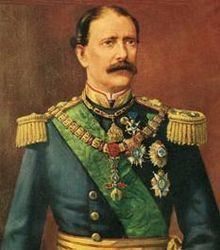Monarch Luis I Monarch Luis I Party Regenerator | Monarch Luis I Role Portuguese statesman Name Fontes de | |
 | ||
Preceded by Antonio Rodrigues Sampaio Succeeded by Antonio Jose de Avila, 1st Duke of Avila and Bolama | ||
Preceded by Antonio Jose de Avila Preceded by Antonio Jose de Avila Education Military Academy (1839) | ||
V deo promocial da escola fontes pereira de melo
António Maria de Fontes Pereira de Melo ([ˈfõtɨʃ pɨˈɾɐjɾɐ dɨ ˈmɛlu]; Lisbon, 8 September 1819 – 22 January 1887) was a Portuguese statesman, politician, and engineer. Historically, he was a very important political figure, deputy, and in several occasions minister, six times Minister of Finance.
Contents
- V deo promocial da escola fontes pereira de melo
- Lista s escola secund ria fontes pereira de melo parte i
- Biography
- President of the Council of Ministers
- Death
- Family
- Legacy
- References

Pereira de Melo is mostly remembered for conducting dynamic industrial and public infrastructure policy which become known as Fontismo (after his name). He also implemented educational reforms in accordance with the industrialization process he initiated (see Instituto Industrial de Lisboa and Escola Industrial do Porto).
Lista s escola secund ria fontes pereira de melo parte i
Biography
He was born to Lisbon and was the son of João de Fontes Pereira de Melo, the 75th and 78th colonial governor of Cape Verde and wife and first cousin Jacinta Venância Rosa da Cunha Matos.
At age 13 in 1832, he studied at the Academy of Marine Guards. The Portuguese Civil War was taken place between the constitionalists and Miguelists (or Michaelists). He sided with the Miguelists and took part in a battle on October 10, where the Miguelist troops commanded by the Marshal of Bourmont which was repelled.
As a young lieutenant was elected deputy for Cape Verde, the candidature was rejected by the commission on 31 March 1848 and no elections took place.
President of the Council of Ministers
He ran for the Regenerator Party starting in 1850. He later became Prime Minster for the first term on 13 September 1871. The government reconstituted the country after the January Revolution and a few governments, entirely disorganized . He succeeded and was later succeeded by Marquess of Ávila He left in 1877 after the banking crisis in 1876. A year later after the 1878 elections, he was again Prime Minister after his electoral victory. A year later, he asked to be dismissed from the cabinet and he left office and Anselmo José Braamcamp organized that cabinet. In 1880, he was president of the Central Commossion of 1 December 1640 In 1881, he was given the presidency of the Chamber of Peers after the death of the Duke of Ávila and Bolama. Later on November 11, Fontes was preparing to create a new government. That new government had a principal mission: modify the state's constitution for the new Additional Act to the Consitutional Chart which was promulgated in 1885, which transformed the Chamber of Peers of hereditary in life. The organization of military reforms made by himself included new regiments in the infantry,two in the cavalry and an artillery, later he started to buy more torpedo boats. He left the government on 16 February 1886. After finishing his third and last term, he was succeeded by José Luciano de Castro.
Death
In 1887, he was preparing for a new opposition campaign over the cabinet and actively directed the electoral works, Pereira de Melo suffered an illness and died on January 22, 1887 at the palace at 6 Páteo do Tijolo in Mercês, Lisbon where he lived.
Family
His younger sister, Maria Henriqueta de Fontes Pereira de Melo, wife of Vicente Rodrigues Ganhado, was granted the noble title of 1st Marchioness of Fontes Pereira de Melo.
Legacy
The Fontes Pereira de Melo Lighthouse in the easternmost point of the island of Santo Antão in northwestern Cape Verde was named for him, it was first constructed when he was Prime Minister in his later years and was completed in the year that he was no longer Prime Minister. Now it is called the Ponta do Tumbo Lighthouse.
